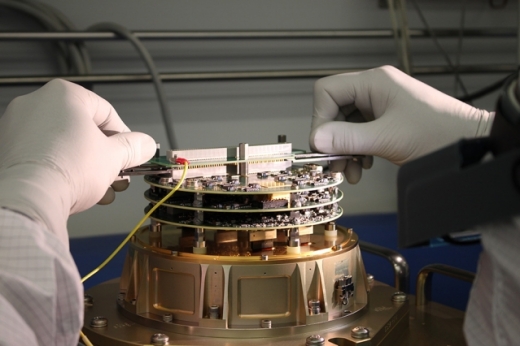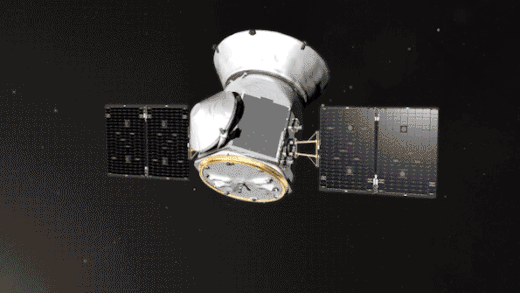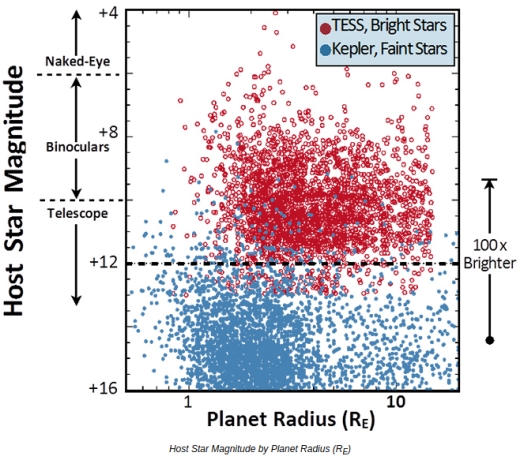The launch of TESS aboard a SpaceX Falcon 9 looks to be on track for Wednesday after yesterday’s delay, which the company attributed to the need for “additional GNC [guidance, navigation and control] analysis.” So we wait just a bit more, knowing that the payoff justifies the caution. We should be identifying planets in the thousands, and around bright, nearby stars.
Standing down today to conduct additional GNC analysis, and teams are now working towards a targeted launch of @NASA_TESS on Wednesday, April 18.
— SpaceX (@SpaceX) April 16, 2018
Principal investigator George Ricker and team have been through the process of designing, building and launching a mission before. It was in 2000 that NASA launched the MIT-built High Energy Transient Explorer 2, or HETE-2, that studied gamma-ray bursts for seven years in Earth orbit. A key technology for HETE-2 was the CCD — charge-coupled device — which allowed the satellite’s optical and X-ray cameras to record bursts in electronic format.
“With the advent of CCDs in the 1970s, you had this fantastic device … which made a lot of things easier for astronomers,” says HETE-2 team member Joel Villasenor, who is now also instrument scientist for TESS. “You just sum up all the pixels on a CCD, which gives you the intensity, or magnitude, of light. So CCDs really broke things open for astronomy.”

Image: A set of flight camera electronics on one of the TESS cameras, developed by the MIT Kavli Institute for Astrophysics and Space Research (MKI), will transmit exoplanet data from the camera to a computer aboard the spacecraft that will process it before transmitting it back to scientists on Earth. Credit: MIT Kavli Institute.
HETE-2’s operations led to an obvious question: Could the satellite use its optical cameras to study exoplanets? The spacecraft’s photometry proved to be insufficient for the task of identifying transits, found by the kind of dips in a star’s light that the Kepler mission would use to such success. But transit hunting stayed on Ricker’s mind, and by 2006 his team had proposed HETE-S to NASA, pitching it as a Discovery class mission. It would later become a proposal for a Small Explorer Class mission under its current name, Transiting Exoplanet Survey Satellite. A new plan emerged when NASA passed on the first TESS proposal.
What we have now is a spacecraft that will use a ‘lunar-resonant’ orbit, as this MIT news release explains. Growing out of work at NASA GSFC as well as Orbital ATK, the orbit will take TESS on a highly elliptical path between and Earth and the Moon, a stable configuration Villasenor describes this way:
“The moon and the satellite are in a sort of dance,” Villasenor says. “The moon pulls the satellite on one side, and by the time TESS completes one orbit, the moon is on the other side tugging in the opposite direction. The overall effect is the moon’s pull is evened out, and it’s a very stable configuration over many years. Nobody’s done this before, and I suspect other programs will try to use this orbit later on.”

The planned trajectory takes the spacecraft on a swing toward the Moon (with apogee near the Moon’s distance) and then a swing back toward the Earth, a stable orbit one benefit of which is that TESS will not need to perform regular thruster burns to maintain its orbit. With Kepler ending its original exoplanet survey, NASA approved the revamped TESS in 2013 as an Explorer class mission. Kepler’s success was obviously a huge motivator, demonstrating the ubiquity of planets around stars and highlighting the good science that could be done on a mission with a wider view that could scan the nearest stars.
Because many of the nearby stars of high interest are red dwarfs, TESS is built around ‘deep depletion’ CCDs that can detect light in a wide range of wavelengths into the near infrared. Once launched, TESS will begin observations in the southern hemisphere and will divide the sky into thirteen ‘stripes,’ with each of these being monitored for 27 days before the cameras are turned to the next. This method should allow almost the entire southern hemisphere sky to be monitored in the first year, after which TESS will turn its attention to the northern hemisphere.
As to data collection, here’s what NASA says:
TESS has two data collection modes: “postage stamp” images that capture light from individual stars and full-frame images that cover the entire field of view. During an observation sector, 15,000 stars selected from a carefully curated list of 200,000 stars make up the primary targets for exoplanet detection, and TESS will record their brightness every two minutes. Images covering the entire 24-by-96-degree field of view will be acquired at 30-minute intervals. Exoplanets will be found using both data products.

Image: From the transit data alone, scientists will be able to determine the size of the planets and orbital parameters. Ground-based follow-up observations of these objects, possible because of the brightness of the host stars, will allow the determination of the planetary masses. Combining the two, radius and mass, will allow astronomers to determine the density of planets, and hence their bulk composition (are they gas giants? water worlds? big rocks, like Earth?). In addition, transit observations can be used to study the dynamics of planetary systems, such as planet-planet interactions and mutual inclinations. Additional follow-up observations, largely from space with HST and JWST, will allow direct measurement of the atmospheric composition and structure of some planets. This will open the door for a host of new discoveries about exoplanets, and perhaps of the processes behind the formation and evolution of planetary systems. Credit: NASA GSFC.
Once in space, TESS will undergo a 60-day commissioning phase involving instrument calibration and calculations of the spacecraft’s trajectory and performance. After that, data collection commences as TESS produces what the science team will need to generate the necessary light curves. MIT’s Sara Seager and the TESS science team will go to work on the light curves, with mass as a key determinant. The TESS stars are close and bright enough to allow mass determination via ground-based radial velocity methods. As Seager says:
“Mass is a defining planetary characteristic. If you just know that a planet is twice the size of Earth, it could be a lot of things: a rocky world with a thin atmosphere, or what we call a “mini-Neptune” — a rocky world with a giant gas envelope, where it would be a huge greenhouse blanket, and there would be no life on the surface. So mass and size together give us an average planet density, which tells us a huge amount about what the planet is.”
If all goes as planned, TESS should discover, among its thousands of exoplanets, hundreds that are less than twice the size of the Earth. The primary goal here is to identify small worlds where follow-up observations can be made with current or planned telescopes. The James Webb Space Telescope will then have the opportunity to use the TESS target list for deeper investigation, and there will also be useful synergies with the European Space Agency’s CHaracterising ExOPlanets Satellite (CHEOPS), scheduled for launch next year.
But first we have to get the mission off. All eyes on Florida for tomorrow’s attempt.



One additional difference between Kepler and TESS is that Kepler looked for planets in one isolated region of the sky whereas TESS will scan a much larger area of the celestial sphere for exoplanets, right? Given that Kepler searched one region of the sky in the constellation Cygnus, one might wonder if its results on planet occurrence are the same for other parts of the galaxy. Since TESS will observe different patches of the sky, will this enable astronomers to test for variations in the planet occurrence rate across different parts of the galaxy?
Personally, I don’t expect wide variations in planet occurrence rates across the galaxy. It is worth noting that microlensing searches and the Kepler mission both suggest a fraction of stars with planets approaching unity even though these techniques look at different regions of the galaxy– so we already have some data on this question. However, microlensing is more geared toward finding outer planets and transit photometry is more geared toward finding close-in planets.
I am excited about Tess, but what do not understand is why we do not do systematic search for stars with planets in our own neighbourhood, say our closest 10-20 stars?
The transit technique is limited. To see a planet transit its orbit must be aligned with our line of sight to within a couple of degrees at best. Planetary systems are orientated randomly with respect to us, so this means the vast majority of stars do not show any transits, despite the fact we know that pretty much all stars have some kind of planetary system.
For example the recently discovered Proxima b has a geometric probability to transit of only about 1.5%; and that’s relatively high for a planet because it is close to its star, the further away a planet is from its star the probability we will see it transit drops considerably more to a fraction of a percent.
This means that if you were to do a survey of the nearest 10-20 stars the chances are high that you will not see a single transiting planet. Transits are great if you manage to see them, but it’s luck of the draw. This is precisely why Kepler stared at hundreds of thousands of stars to find a couple of thousand planetary systems.
Now you can use Radial Velocity which can in theory detect a much wider range of planetary system alignments but until recently these were not sensitive enough to see low-mass planets and there are complications because many stars are not nice and quiet enough to see a signal amongst the noise (this is partly why it took so long to find Proxima b).
Daniel, you are asking a question that must be troubling me and so many others. Why are there no missions designed to take an intense look at our closest ten-to-20-or-so star systems?? It’s like a man or woman getting on a dating site and finding that all the hits the site delivers are 700 to 1,500 miles away! That makes for lonely Saturday nights.
Excellent question, Daniel! I have often wondered the same thing myself. There should be a dedicated search of these nearby stars especially when you consider how many planets have been found within 10-20 light years even without such a dedicated campaign.
Maybe this is where Project Blue comes in:
https://centauri-dreams.org/2017/09/29/project-blue-looking-for-terrestrial-worlds-at-alpha-centauri/
Ricker stated that TESS had fuel reserves for at least 10 years. So, I hope if an extended mission is approved, an observation regimen around the ecliptic poles is prioritised since that would maximize the number of long period planets detected, ie potentially objects in the HZ of K or G class stars.
TESS isn’t a direct replacement for Kepler, it is much more focused. In terms of its ability to see transits it is actually inferior; TESS’s cameras are just 10 cm across compared to Kepler’s 1 meter aperture. Although TESS is looking at brighter stars which partially compensates it will not be as sensitive as Kepler. This means it will not be able to see the transits of rocky planets around K and G type stars, only Ms where the transit is relatively large. There are other things mission extensions could do, but it won’t be able to see potentially habitable planets around Sun-like stars.
This is in part the motivation for ESA’s PLATO mission which is effectively a mix between the two; as sensitive as Kepler but with a large field of view like TESS to find rocky planets in the habitable zone of bright stars like the Sun.
Will PLATO be more capable than Kepler of detecting earth-sized planets in the habitable zone of G type MS stars?
Yes, because it’s sample of G stars will be brighter.
“it will not be as sensitive as Kepler”
What matters for this mission is intensity resolution, not sensitivity, since we’re measuring variation. A high dynamic range can also be helpful depending on the field of view.
@Sam Goodman, I don’t think you are correct about TESS not being able to detect planets around K and G stars. It’s the light gathering power of the mirror which is dependent on the size of the mirror and not the camera. There were a lot of exoplanets in alignment with Kepler so there will be a lot with TESS which has nothing to do with the camera.
Of course TESS will be able to detect planets around G and K stars, I said ROCKY planets (<1.5 Earth radii); TESS will only be able to see a handful of these around FGK stars because there simply aren't the numbers that are bright enough to compensate for the relatively low photometric precision. And the number of G and K stars that are bright enough to detect small transits AND have a long-period HZ rocky planet favourably aligned is even smaller…
Quote by Sam Goodman: “TESS will only be able to see a handful of these around FGK stars because there simply aren’t the numbers that are bright enough to compensate for the relatively low photometric precision.” Please site some references to support this opinion.
I think TESS is a very well conceived mission and will give us a wealth of knowledge about exoplanets in our neighborhood if it works according to design.
I was thinking that a large telescope main objective aperture is not needed for exoplanet transit photometry if the planets are nearby since one is only looking at the dimming of the light of the star and not the spectroscopy which needs a large mirror.